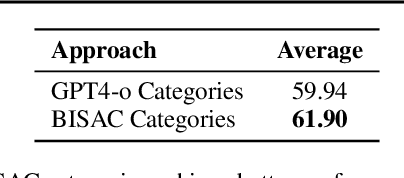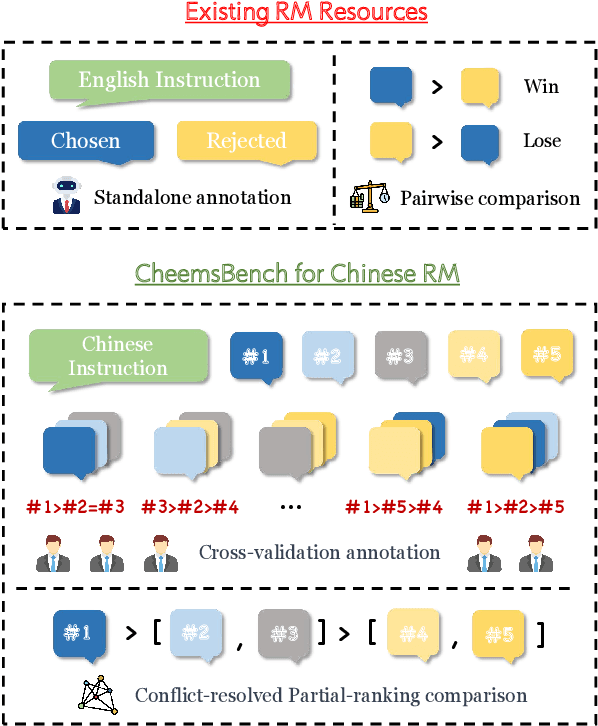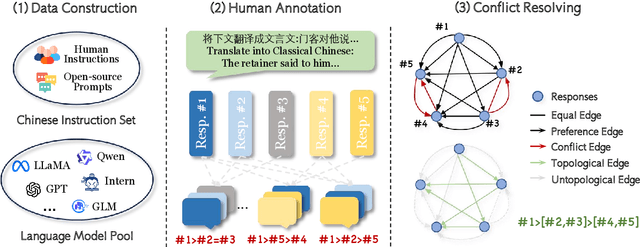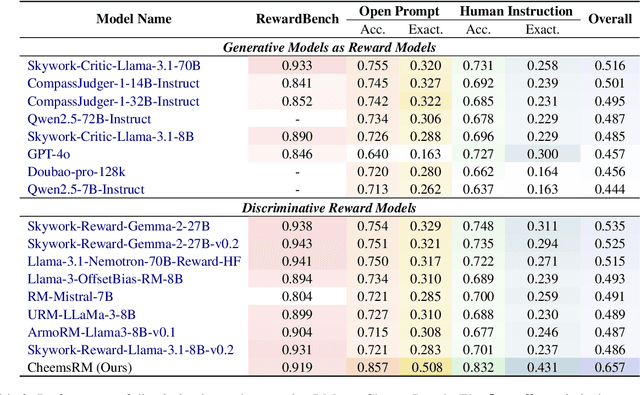Debing Zhang
Coupled Variational Reinforcement Learning for Language Model General Reasoning
Dec 14, 2025Abstract:While reinforcement learning have achieved impressive progress in language model reasoning, they are constrained by the requirement for verifiable rewards. Recent verifier-free RL methods address this limitation by utilizing the intrinsic probabilities of LLMs generating reference answers as reward signals. However, these approaches typically sample reasoning traces conditioned only on the question. This design decouples reasoning-trace sampling from answer information, leading to inefficient exploration and incoherence between traces and final answers. In this paper, we propose \textit{\b{Co}upled \b{V}ariational \b{R}einforcement \b{L}earning} (CoVRL), which bridges variational inference and reinforcement learning by coupling prior and posterior distributions through a hybrid sampling strategy. By constructing and optimizing a composite distribution that integrates these two distributions, CoVRL enables efficient exploration while preserving strong thought-answer coherence. Extensive experiments on mathematical and general reasoning benchmarks show that CoVRL improves performance by 12.4\% over the base model and achieves an additional 2.3\% improvement over strong state-of-the-art verifier-free RL baselines, providing a principled framework for enhancing the general reasoning capabilities of language models.
LiteLong: Resource-Efficient Long-Context Data Synthesis for LLMs
Sep 19, 2025



Abstract:High-quality long-context data is essential for training large language models (LLMs) capable of processing extensive documents, yet existing synthesis approaches using relevance-based aggregation face challenges of computational efficiency. We present LiteLong, a resource-efficient method for synthesizing long-context data through structured topic organization and multi-agent debate. Our approach leverages the BISAC book classification system to provide a comprehensive hierarchical topic organization, and then employs a debate mechanism with multiple LLMs to generate diverse, high-quality topics within this structure. For each topic, we use lightweight BM25 retrieval to obtain relevant documents and concatenate them into 128K-token training samples. Experiments on HELMET and Ruler benchmarks demonstrate that LiteLong achieves competitive long-context performance and can seamlessly integrate with other long-dependency enhancement methods. LiteLong makes high-quality long-context data synthesis more accessible by reducing both computational and data engineering costs, facilitating further research in long-context language training.
Flow-Anything: Learning Real-World Optical Flow Estimation from Large-Scale Single-view Images
Jun 09, 2025Abstract:Optical flow estimation is a crucial subfield of computer vision, serving as a foundation for video tasks. However, the real-world robustness is limited by animated synthetic datasets for training. This introduces domain gaps when applied to real-world applications and limits the benefits of scaling up datasets. To address these challenges, we propose \textbf{Flow-Anything}, a large-scale data generation framework designed to learn optical flow estimation from any single-view images in the real world. We employ two effective steps to make data scaling-up promising. First, we convert a single-view image into a 3D representation using advanced monocular depth estimation networks. This allows us to render optical flow and novel view images under a virtual camera. Second, we develop an Object-Independent Volume Rendering module and a Depth-Aware Inpainting module to model the dynamic objects in the 3D representation. These two steps allow us to generate realistic datasets for training from large-scale single-view images, namely \textbf{FA-Flow Dataset}. For the first time, we demonstrate the benefits of generating optical flow training data from large-scale real-world images, outperforming the most advanced unsupervised methods and supervised methods on synthetic datasets. Moreover, our models serve as a foundation model and enhance the performance of various downstream video tasks.
dots.llm1 Technical Report
Jun 06, 2025Abstract:Mixture of Experts (MoE) models have emerged as a promising paradigm for scaling language models efficiently by activating only a subset of parameters for each input token. In this report, we present dots.llm1, a large-scale MoE model that activates 14B parameters out of a total of 142B parameters, delivering performance on par with state-of-the-art models while reducing training and inference costs. Leveraging our meticulously crafted and efficient data processing pipeline, dots.llm1 achieves performance comparable to Qwen2.5-72B after pretraining on 11.2T high-quality tokens and post-training to fully unlock its capabilities. Notably, no synthetic data is used during pretraining. To foster further research, we open-source intermediate training checkpoints at every one trillion tokens, providing valuable insights into the learning dynamics of large language models.
Uni-Instruct: One-step Diffusion Model through Unified Diffusion Divergence Instruction
May 27, 2025Abstract:In this paper, we unify more than 10 existing one-step diffusion distillation approaches, such as Diff-Instruct, DMD, SIM, SiD, $f$-distill, etc, inside a theory-driven framework which we name the \textbf{\emph{Uni-Instruct}}. Uni-Instruct is motivated by our proposed diffusion expansion theory of the $f$-divergence family. Then we introduce key theories that overcome the intractability issue of the original expanded $f$-divergence, resulting in an equivalent yet tractable loss that effectively trains one-step diffusion models by minimizing the expanded $f$-divergence family. The novel unification introduced by Uni-Instruct not only offers new theoretical contributions that help understand existing approaches from a high-level perspective but also leads to state-of-the-art one-step diffusion generation performances. On the CIFAR10 generation benchmark, Uni-Instruct achieves record-breaking Frechet Inception Distance (FID) values of \textbf{\emph{1.46}} for unconditional generation and \textbf{\emph{1.38}} for conditional generation. On the ImageNet-$64\times 64$ generation benchmark, Uni-Instruct achieves a new SoTA one-step generation FID of \textbf{\emph{1.02}}, which outperforms its 79-step teacher diffusion with a significant improvement margin of 1.33 (1.02 vs 2.35). We also apply Uni-Instruct on broader tasks like text-to-3D generation. For text-to-3D generation, Uni-Instruct gives decent results, which slightly outperforms previous methods, such as SDS and VSD, in terms of both generation quality and diversity. Both the solid theoretical and empirical contributions of Uni-Instruct will potentially help future studies on one-step diffusion distillation and knowledge transferring of diffusion models.
LongMagpie: A Self-synthesis Method for Generating Large-scale Long-context Instructions
May 22, 2025Abstract:High-quality long-context instruction data is essential for aligning long-context large language models (LLMs). Despite the public release of models like Qwen and Llama, their long-context instruction data remains proprietary. Human annotation is costly and challenging, while template-based synthesis methods limit scale, diversity, and quality. We introduce LongMagpie, a self-synthesis framework that automatically generates large-scale long-context instruction data. Our key insight is that aligned long-context LLMs, when presented with a document followed by special tokens preceding a user turn, auto-regressively generate contextually relevant queries. By harvesting these document-query pairs and the model's responses, LongMagpie produces high-quality instructions without human effort. Experiments on HELMET, RULER, and Longbench v2 demonstrate that LongMagpie achieves leading performance on long-context tasks while maintaining competitive performance on short-context tasks, establishing it as a simple and effective approach for open, diverse, and scalable long-context instruction data synthesis.
MLLM-Selector: Necessity and Diversity-driven High-Value Data Selection for Enhanced Visual Instruction Tuning
Mar 26, 2025Abstract:Visual instruction tuning (VIT) has emerged as a crucial technique for enabling multi-modal large language models (MLLMs) to follow user instructions adeptly. Yet, a significant gap persists in understanding the attributes of high-quality instruction tuning data and frameworks for its automated selection. To address this, we introduce MLLM-Selector, an automated approach that identifies valuable data for VIT by weighing necessity and diversity. Our process starts by randomly sampling a subset from the VIT data pool to fine-tune a pretrained model, thus creating a seed model with an initial ability to follow instructions. Then, leveraging the seed model, we calculate necessity scores for each sample in the VIT data pool to identify samples pivotal for enhancing model performance. Our findings underscore the importance of mixing necessity and diversity in data choice, leading to the creation of MLLM-Selector, our methodology that fuses necessity scoring with strategic sampling for superior data refinement. Empirical results indicate that within identical experimental conditions, MLLM-Selector surpasses LLaVA-1.5 in some benchmarks with less than 1% of the data and consistently exceeds performance across all validated benchmarks when using less than 50%.
The Devil Is in the Details: Tackling Unimodal Spurious Correlations for Generalizable Multimodal Reward Models
Mar 05, 2025Abstract:Multimodal Reward Models (MM-RMs) are crucial for aligning Large Language Models (LLMs) with human preferences, particularly as LLMs increasingly interact with multimodal data. However, we find that MM-RMs trained on existing datasets often struggle to generalize to out-of-distribution data due to their reliance on unimodal spurious correlations, primarily text-only shortcuts within the training distribution, which prevents them from leveraging true multimodal reward functions. To address this, we introduce a Shortcut-aware MM-RM learning algorithm that mitigates this issue by dynamically reweighting training samples, shifting the distribution toward better multimodal understanding, and reducing dependence on unimodal spurious correlations. Our experiments demonstrate significant improvements in generalization, downstream task performance, and scalability, establishing a more robust framework for multimodal reward modeling.
LoRA-Null: Low-Rank Adaptation via Null Space for Large Language Models
Mar 04, 2025Abstract:Low-Rank Adaptation (LoRA) is the leading parameter-efficient fine-tuning method for Large Language Models (LLMs). However, the fine-tuned LLMs encounter the issue of catastrophic forgetting of the pre-trained world knowledge. To address this issue, inspired by theoretical insights of null space, we propose LoRA-Null, i.e., Low-Rank Adaptation via null space, which builds adapters initialized from the null space of the pre-trained knowledge activation. Concretely, we randomly collect a few data samples and capture their activations after passing through the LLM layer. We perform Singular Value Decomposition on the input activations to obtain their null space. We use the projection of the pre-trained weights onto the null space as the initialization for adapters. Experimental results demonstrate that this initialization approach can effectively preserve the original pre-trained world knowledge of the LLMs during fine-tuning. Additionally, if we freeze the values of the down-projection matrices during fine-tuning, it achieves even better preservation of the pre-trained world knowledge. LoRA-Null effectively preserves pre-trained world knowledge while maintaining strong fine-tuning performance, as validated by extensive experiments on LLaMA series (LLaMA2, LLaMA3, LLaMA3.1, and LLaMA3.2) across Code, Math, and Instruction Following tasks. We also provide a theoretical guarantee for the capacity of LoRA-Null to retain pre-trained knowledge. Code is in https://github.com/HungerPWAY/LoRA-Null.
Cheems: A Practical Guidance for Building and Evaluating Chinese Reward Models from Scratch
Feb 24, 2025



Abstract:Reward models (RMs) are crucial for aligning large language models (LLMs) with human preferences. However, most RM research is centered on English and relies heavily on synthetic resources, which leads to limited and less reliable datasets and benchmarks for Chinese. To address this gap, we introduce CheemsBench, a fully human-annotated RM evaluation benchmark within Chinese contexts, and CheemsPreference, a large-scale and diverse preference dataset annotated through human-machine collaboration to support Chinese RM training. We systematically evaluate open-source discriminative and generative RMs on CheemsBench and observe significant limitations in their ability to capture human preferences in Chinese scenarios. Additionally, based on CheemsPreference, we construct an RM that achieves state-of-the-art performance on CheemsBench, demonstrating the necessity of human supervision in RM training. Our findings reveal that scaled AI-generated data struggles to fully capture human preferences, emphasizing the importance of high-quality human supervision in RM development.
 Add to Chrome
Add to Chrome Add to Firefox
Add to Firefox Add to Edge
Add to Edge